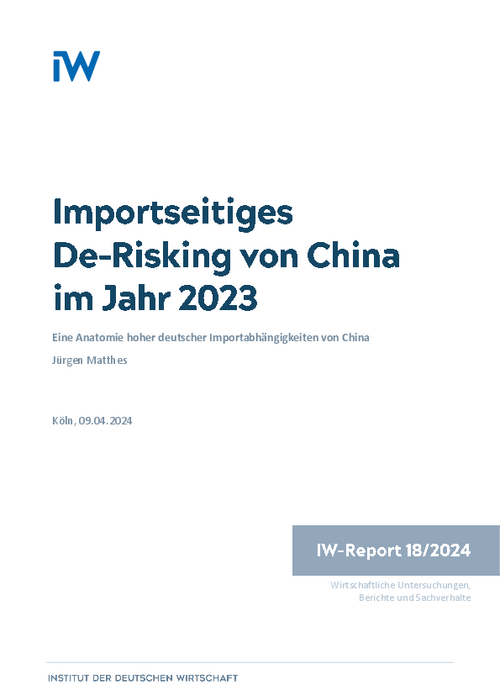Despite certain changes, German import dependencies on China remained at a similar level overall in 2023 as in the previous year in the overall picture. This means that de-risking on the import side can only be recognised to a limited extent.

Import side De-risking China in 2023: An anatomy of high German import dependencies on China

Despite certain changes, German import dependencies on China remained at a similar level overall in 2023 as in the previous year in the overall picture. This means that de-risking on the import side can only be recognised to a limited extent.
This is shown by the IW monitoring of industry-related 8-digit product groups in foreign trade statistics with high and therefore potentially critical import dependencies, defined as imports with a share from China of at least 50 per cent.
In a comparison of the years 2022 and 2023, there were certain changes in import dependency on China, but these had only a limited effect for various reasons. For example, the import values and import shares of industry-related product groups with high import dependencies on China have fallen significantly. However, this is largely due to one-off special effects. On the one hand, this includes a special development for a single chemical product, and on the other hand, there was very likely a reduction in stocks of computer-related products that had been built up in 2022 due to supply bottlenecks. A clear structural de-risking – in the sense of a continuing trend towards further significant declines in imports – is therefore not yet apparent. There were also significant shifts in the number of product groups with potentially critical German import dependencies on China in 2022. For example, 73 product groups were removed from the list as their China import share fell below 50 per cent. However, only a slightly smaller number of product groups that exceeded this threshold were added in 2023. This means that the number of industry-related product groups with a high dependency on imports from China in the definition used here fell only slightly between 2022 and 2023, from 213 to around 200. In addition, the basic structure of import dependencies has remained roughly the same.
An analysis of the identified dependencies in 2023 shows that 85 product groups with high import shares belong to the product category of chemical (and related) products for the industry-related definition used here. The category of electrical and electronic products follows at some distance with 38 product groups which include laptops, computer accessories, solar cells, magnets and batteries. Mechanical engineering products and the category raw materials and minerals each contain 24 product groups, including six rare earth metals. The other product categories each include significantly fewer groups. An analysis since 2013 shows that a hard core of nearly 5 dozen product groups with persistently high import dependencies on China has emerged in recent years. In addition, the sample of the product group list for 2023 indicates that the number of product groups with high import dependencies has increased significantly over time. This also shows that the problem of potentially critical import dependencies on China has tended to worsen in recent years.
The empirical analysis can only identify potentially critical import dependencies. However, in order to implement the German government's de-risking strategy, it is important to identify actual critical import dependencies. To this end, it must be determined whether the products identified are indispensable and cannot be adequately replaced in the short term and, if so, what damage their absence would mean for Germany. To this end, it seems essential to make the expert knowledge in companies available to the state on a strictly confidential basis. A concrete proposal is submitted for this purpose.

Import side De-risking China in 2023: An anatomy of high German import dependencies on China

More on the topic
![[Translate to English:] Das Gebäude des Weißen Hauses in Washington, D.C. in den Vereinigten Staaten von Amerika. [Translate to English:] Das Gebäude des Weißen Hauses in Washington, D.C. in den Vereinigten Staaten von Amerika.](/fileadmin/_processed_/c/1/csm_GettyImages-2161499385_White_House_Editorial_884306add8.jpg)
Trump or Harris or ...? What Europe must prepare for
A few months before the presidential election in the USA, Donald Trump has a good chance of being re-elected. On the Democratic side, the incumbent president has withdrawn his candidacy after a long period of hesitation, while Vice President Kamala Harris is ...
IW
Competitive pressure from China for German companies
A firm survey conducted in March/April 2024 as part of the IW-Zukunftspanel among around 900 German companies from the manufacturing and industrial services sectors shows that around 350 of the companies surveyed have Chinese competitors in their markets.
IW